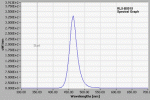In researching this here's what I found. Please correct me where I've made mistakes.
1 250 watt MH 6500K bulb is approx 14000 lumens
1 bright white LED is between 5000-10000 mcd
1 mcd = (lumens*1000)/12.57 so
140 8000mcd white LCDs = 1 250 250 watt MH 6500K bulb
The cost of the LEDS is about $1.49 each so it would cost $210 for the bulbs which is way more than a MH bulb. However the power consumption may mediate this. Ignoring loss due to the transformer:
1 LED uses 20mA and 3.3V
Since a watts are volts times amps I figure that
140bulbs * .02A * 3.3V = 9.24 watts
According to the manufacturer the LEDs keep their potency for about half their MAX life which is 30000 hours. So 15000 hours / 12 hours per day is about 3.5 years of life. That would use about 3600 less kWh in its lifespan. Even at $.05 a kWh that would be $185 less energy. At higher energy costs it would be even more beneficial.
The image I'm attaching from Super Bright LEDs shows the wavelength distribution for the bright white LEDS.
1 250 watt MH 6500K bulb is approx 14000 lumens
1 bright white LED is between 5000-10000 mcd
1 mcd = (lumens*1000)/12.57 so
140 8000mcd white LCDs = 1 250 250 watt MH 6500K bulb
The cost of the LEDS is about $1.49 each so it would cost $210 for the bulbs which is way more than a MH bulb. However the power consumption may mediate this. Ignoring loss due to the transformer:
1 LED uses 20mA and 3.3V
Since a watts are volts times amps I figure that
140bulbs * .02A * 3.3V = 9.24 watts
According to the manufacturer the LEDs keep their potency for about half their MAX life which is 30000 hours. So 15000 hours / 12 hours per day is about 3.5 years of life. That would use about 3600 less kWh in its lifespan. Even at $.05 a kWh that would be $185 less energy. At higher energy costs it would be even more beneficial.
The image I'm attaching from Super Bright LEDs shows the wavelength distribution for the bright white LEDS.







